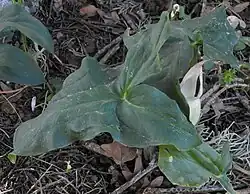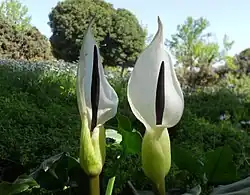Arum idaeum
| Arum idaeum | |
|---|---|

| |
| Scientific classification | |
| Kingdom: | Plantae |
| Clade: | Tracheophytes |
| Clade: | Angiosperms |
| Clade: | Monocots |
| Order: | Alismatales |
| Family: | Araceae |
| Genus: | Arum |
| Species: | A. idaeum
|
| Binomial name | |
| Arum idaeum | |
 Range of A. idaeum[1] (precise locations only) | |
Arum idaeum is a woodland plant species of the family Araceae. It is found on Crete.
Description

It has an ovate tuber.[3]
The plant grows 18–22 centimetres (7.1–8.7 in) tall. Stalk base and lower third of petioles is red-veined. Stem is white. Leaves immaculate, and smaller than some coterminous species; ovate-triangular in outline, their lobes horizontally lanceolate, peduncle equal to the leaves.[4]
Spathe is usually almost white, shorter, concolorous, white appendix, far exceeding the spathe, male ring much shorter than female.[4]
Berry is angular, ovate.[5]
Distribution and habitat
It has been recorded at elevations of 1060–1981 m.[1] It often grows under thickets of Berberis cretica.[3]
Ecology
Flowers June–July.[3]
Taxonomy
Together with Arum creticum it has been placed in subsection Cretica,[6] which has been confirmed through genetic testing. They are estimated to have split about 2.2 Mya. No other species are related within 5 Mya.[7]
It was discovered as a species on Mount Ida in 1913–1914 by botanists Paul Cousturier and Michel Gandoger.[3]
References
- ^ a b GBIF 2025.
- ^ Kew 2023.
- ^ a b c d Cousturier & Gandoger 1917, p. 14.
- ^ a b Cousturier & Gandoger 1917, p. 14,15.
- ^ Cousturier & Gandoger 1917, p. 15.
- ^ Boyce 1989.
- ^ Linz et al. 2010.
Bibliography
- GBIF (2025-05-23). "Arum idaeum Coustur. & Gand. Occurrence Download". Global Biodiversity Information Facility. doi:10.15468/dl.je2nan.
- Kew (2023). "Arum rupicola Boiss". International Plant Names Index and World Checklist of Vascular Plants.
- Linz, Jeanine; Stökl, Johannes; Urru, Isabella; Krügel, Tamara; Stensmyr, Marcus C.; Hansson, Bill S. (2010-04-01). "Molecular phylogeny of the genus Arum (Araceae) inferred from multi–locus sequence data and AFLPs". Taxon. 59 (2): 405–415. Bibcode:2010Taxon..59..405L. doi:10.1002/tax.592006. eISSN 1996-8175.
- Kite, Geoffrey C.; et al. (2000). "Inflorescence odours and pollinators of Arum and Amorphophallus (Araceae)" (PDF). Reproductive Biology in Systematics, Conservation and Economic Botany. pp. 295–315. ISBN 1900347628.
- Boyce, Peter C. (1989). "A New Classification of Arum with Keys to the Infrageneric Taxa". Kew Bulletin. 44 (3): 383–395. Bibcode:1989KewBu..44..383B. doi:10.2307/4110359. ISSN 0075-5974. JSTOR 4110359.
- Cousturier, Paul; Gandoger, Michel (1916). "Herborisations en Crète (1913–1914)". Bulletin de la Société botanique de France. 63 (published 1917): 1–15. ISSN 0181-1789.